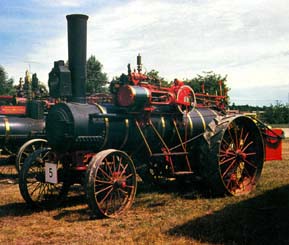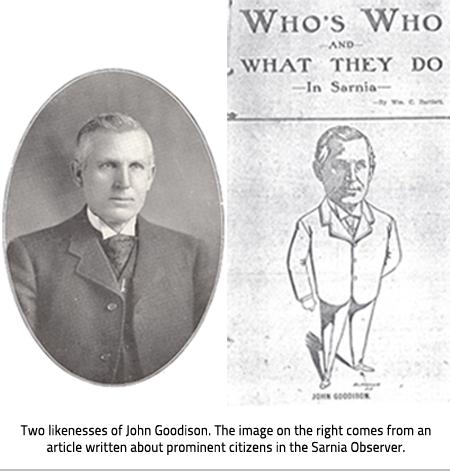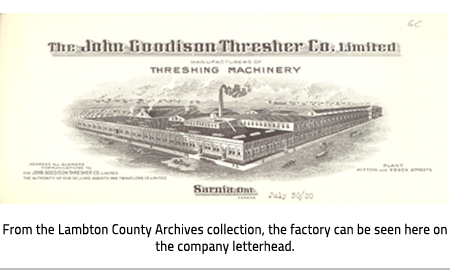John Goodison (1849-1915)
By the fall of 1889, Goodison again secured sole
ownership of the business and renamed it the Tunnel City Thresher Works, but
soon changed it to the John Goodison Threshing Company.
By: Sarah Creswell and Tom Flint, P.Eng.

Goodison was one of Sarnia's most prominent and highly
respected citizens. He was also known far and wide throughout the Dominion of
Canada as the manufacturer of the Goodison Threshing Machine and Traction
Engines.
Goodison was born in Wicklow, Ireland. His parents, five brothers and two
sisters and John moved to Canada in 1857, when he was eight years old, to settle
on a farm near Toronto. After some time, they moved to Strathroy, where he
conducted business for 14 years, building up a good trade. Selling out, he and
his wife Ida Marger and two sons, Edwin Francis and William Thomas, moved to
Sarnia in 1882. There, he worked for the Sarnia Agricultural Implement Company
that operated a factory for manufacturing implements. The company was founded by
F. J. Craig of Strathroy in the previous year with the encouragement of the
Sarnia city council. They were successful in making reapers, threshers, mowers,
plows, cornshellers, etc. and expanded in 1884. However, in 1886, they were
forced into liquidation as the result of adverse experimentation and
manufacturing difficulties. Goodison, together with George H. Samis, purchased
the interest and factory of the insolvent company and operated it successfully.
The following season, it was sold to Sawyer-Massey Company of Hamilton. The new
firm retained Goodison as the manager.
By the fall of 1889, Goodison again secured sole ownership of the business
and renamed it the Tunnel City Thresher Works, but soon changed it to the John
Goodison Threshing Company. With a great deal of determination and business
sense, he succeeded in building the most thriving threshing machine industry in
Ontario, and arguably the only Canadian firm to successfully penetrate the
American market. The factory, located in Sarnia, was situated on Mitton Street
between Essex and Maria streets. The frontage covered the entire distance of
Mitton Street and occupied three quarters of the block. Part of it was factory,
but most was plant yard.

Around this time, John McCloskey of London was becoming famous for the
success of his design of threshing machines. In 1892, John Goodison secured the
rights to build the machine and persuaded McCloskey to work for him for 10
years, until McCloskey's death in 1902. In 1897, Goodison decided to concentrate
on making threshers only. The firm made many improvements in thresher design.
Being the first manufacturer to add windstackers, which blew straw from the
machine to a storage pile, they added grain elevators to fill grain bins
directly. Also, self-feeders conveyed the sheaths into the machine by means of a
carrier. Refinements were made as well. The customers appreciated the
improvements, and the company flourished.
The Goodison firm built no engines at first, but supplied customers with
complete outfits with the Waterous 17-horsepower "Ontario Standard" portable
one-cylinder steam engine for Eastern Canada and a heavier double-cylinder
version for the West. The boiler was a locomotive type with a high dome. The
side crank engines were mounted on the top with the cylinder towards the smoke
box. The reverse gear was the Woolf single eccentric and a lever-controlled
brake. The clutch was internal expanding, with two large metal shoes. The
original design never changed. Formerly, the motive power for the threshers had
been various horse treadmills.
In 1902, they built their own engine sets with Waterous boilers. Two years
later, they started manufacturing traction engines. With the portable steam
engines, it required three teams of horses to transport the thresher machine,
the engine and the water wagon. Using a traction engine for powering the
thresher and for hauling reduced the horse teams to one.
These were the times of the opening up of Western Canada. Although Goodison
machines were used extensively in Western Canada, the company never established
a Western branch. They did establish sales agencies in the U.S. and sold more
machines there than any other Canadian threshing machine company. Goodison
machines could be found in every state in the U.S., the Canadian northwest,
Argentina and South America.
John Goodison (1849-1915)
By the fall of 1889, Goodison again secured sole
ownership of the business and renamed it the Tunnel City Thresher Works, but
soon changed it to the John Goodison Threshing Company.
By: Sarah Creswell and Tom Flint, P.Eng.

In 1914, the company employed 150 men in different departments of the plant
and six travelling salesmen. The company policy of "Good goods and a square
deal" helped them to be recognized as one of the most modern single grade of
machines on the market.
The greatest setback the company faced was the St. Patrick's Day fire of
March 17, 1914, which destroyed storage sheds and 200 newly completed threshers
that were ready for shipment. Despite the more than $200,000 loss, the company
was able to survive.
John Goodison was a member of city council from 1906 to 1915, excluding 1912,
and he also served on county council. He and his two sons owned a stock farm
near the city. One of his other interests was an oil field located in Moore
Township. On the 200 acres, there were eight producing wells. He was a member of
the Methodist Church. He was a Liberal and wielded considerable influence. Also,
he was a member of the Masonic craft and the Beaver Lodge of Strathroy.
On May 5, 1915, Goodison secured a large order of 300 threshers for Western
Canada. On the following day, after supervising the loading of the machines on
the rail cars, he did not feel well. His son drove John home, where he passed
away shortly afterwards. Edwin, his son and former secretary, took over the firm
until he died the following year. Johnís son William, previously the treasurer,
assumed the presidency until his death in 1928. Then, C. A. White was appointed
general manager.

The firm continued to prosper despite these deaths. Among the improvements
made were the change to all-steel construction in frames, which completely
replaced wooden frames by 1926, and the gradual adoption of self-aligning,
dustproof ball bearings by 1927.
Also, to keep up with the changing times, the company sold Hart-Parr fuel oil
tractors beginning in 1921. Hart-Parr merged with Oliver in 1930. Fuel oil was
dropped when gasoline was found cheaper to use. Goodison stopped manufacturing
steam traction engines in 1927.
The company, despite the depression in the 1930s, built a new factory in 1936
and became one of the largest thresher companies in Canada.
Bibliography
Peers, Francis. "The History of John
Goodison Thresher Co."
Engineers and Engines June-July 1982:
4-7.
Tremain, Robert. "The John Goodison Thresher Company."
Canadian
Antique Power May-June1993: 8-10.
The Sarnia Canadian
Observer, May 12, 1905 edition.
The Sarnia Canadian
Observer, May 7, 1915 edition.
The Sarnia Canadian
Observer, April 3, 1929 edition.
The London Free Press,
August 14, 1937 edition.
The Petrolia Enniskillen Gazette,
September 7, 1983 edition.
The authors also consulted the Lambton Room Archives of the Lambton County
Library Headquarters in Wyoming, Ontario. The City of Sarnia Registrar, Ms. A.
Tuplin, supplied information on Goodisonís service on council.
Photo credits: Lambton County Heritage Museum




